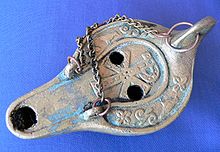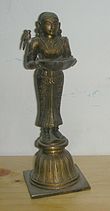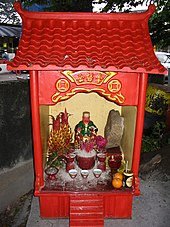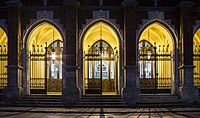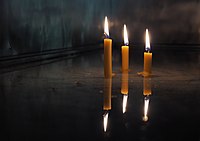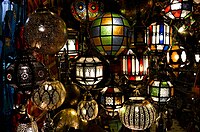
The menorah is a seven-branched candelabrum that is described in the Hebrew Bible and in later ancient sources as having been used in the Tabernacle and in the Temple in Jerusalem.
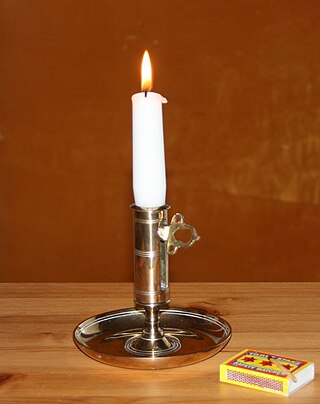
A candle is an ignitable wick embedded in wax, or another flammable solid substance such as tallow, that provides light, and in some cases, a fragrance. A candle can also provide heat or a method of keeping time. Candles have been used for over two millennia around the world, and were a significant form of lighting until the invention of other types of light sources. Although electric light has largely made candle use nonessential for illumination, candles are still commonly used for functional, symbolic and aesthetic purposes and in specific cultural and religious settings. Various devices can be used to hold candles, such as candlesticks, or candelabras, chandeliers, lanterns and sconces. A person who makes candles is traditionally known as a chandler.

A kerosene lamp is a type of lighting device that uses kerosene as a fuel. Kerosene lamps have a wick or mantle as light source, protected by a glass chimney or globe; lamps may be used on a table, or hand-held lanterns may be used for portable lighting. Like oil lamps, they are useful for lighting without electricity, such as in regions without rural electrification, in electrified areas during power outages, at campsites, and on boats. There are three types of kerosene lamp: flat-wick, central-draft, and mantle lamp. Kerosene lanterns meant for portable use have a flat wick and are made in dead-flame, hot-blast, and cold-blast variants.

A lantern is an often portable source of lighting, typically featuring a protective enclosure for the light source – historically usually a candle, a wick in oil, or a thermoluminescent mesh, and often a battery-powered light in modern times – to make it easier to carry and hang up, and make it more reliable outdoors or in drafty interiors. Lanterns may also be used for signaling, as torches, or as general light-sources outdoors.

A chandelier ( is an ornamental lighting device, typically with spreading branched supports for multiple lights, designed to be hung from the ceiling. Chandeliers are often ornate, and they were originally designed to hold candles, but now incandescent light bulbs are commonly used, as well as fluorescent lamps and LEDs.

The word zoomorphism derives from Ancient Greek: ζωον, romanized: zōon, lit. 'animal' and Ancient Greek: μορφη, romanized: morphē, lit. 'form; shape'. In the context of art, zoomorphism could describe art that imagines humans as non-human animals. It can also be defined as art that portrays one species of animal like another species of animal or art that uses animals as a visual motif, sometimes referred to as "animal style." In ancient Egyptian religion, deities were depicted in animal form which is an example of zoomorphism in not only art but in a religious context. It is also similar to the term therianthropy; which is the ability to shape shift into animal form, except that with zoomorphism the animal form is applied to a physical object. It means to attribute animal forms or animal characteristics to other animals, or things other than an animal; similar to but broader than anthropomorphism. Contrary to anthropomorphism, which views animal or non-animal behavior in human terms, zoomorphism is the tendency of viewing human behavior in terms of the behavior of animals. It is also used in literature to portray the act of humans or objects with animalistic behavior or features. The use of zoomorphism served as a decorative element to objects that are typically quite simple in shape and design.
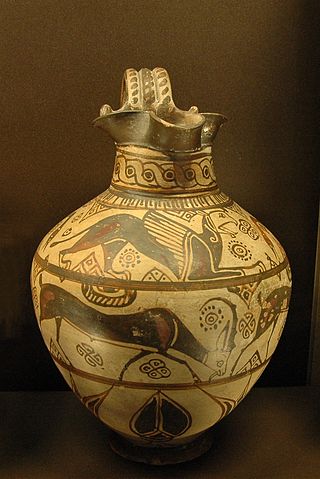
An oenochoe, also spelled oinochoe, is a wine jug and a key form of ancient Greek pottery.
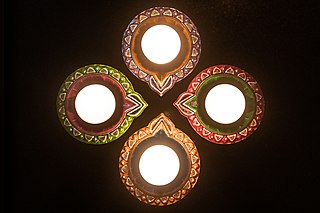
A diya, diyo, deya, deeya, dia, divaa, deepa, deepam, deep, deepak or saaki is an oil lamp made from clay or mud with a cotton wick dipped in oil or ghee. These lamps are commonly used in the Indian subcontinent and they hold sacred prominence in Hindu, Sikh, Buddhist, and Jain prayers as well as religious rituals, ceremonies and festivals including Diwali.

A lampshade is a fixture that envelops the lightbulb on a lamp to diffuse the light it emits. Lampshades can be made out of a large variety of materials like paper, glass, fabric or stone. Oftentimes conical or cylindrical in shape, lampshades can be found on floor, desk, tabletop, or suspended lamps. The term can also apply to the glass hung around many designs of ceiling lamp. Beyond its practical purpose, significant emphasis is also usually given to decorative and aesthetic features. A lamp shade also serves to "shade" human eyes from the direct glare of the light bulbs used to illuminate the lamp. Some lamp shades are also lined with a hard-backed opaque lining, often white or gold, to reflect as much light as possible through the top and bottom of the shade while blocking light from emitting through the walls of the shade itself. In other cases, the shade material is deliberately decorative so that upon illumination it may emphasize a display of color and light emitting through the shade surface itself.
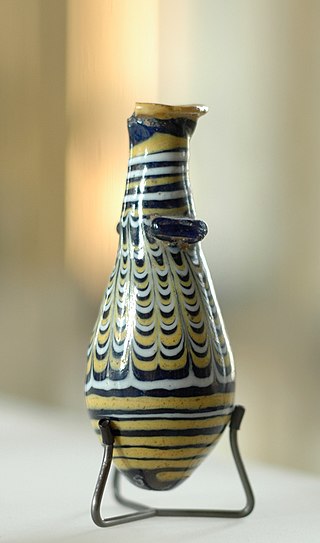
An alabastron or alabastrum is a small type of pottery or glass vessel used for holding oil, especially perfume or massage oils. They originated around the 11th century BC in ancient Egypt as containers carved from alabaster – hence the name – and spread via ancient Greece to other parts of the classical world.

A light fixture, light fitting, or luminaire is an electrical lighting device containing one or more light sources, such as lamps, and all the accessory components required for its operation to provide illumination to the environment. All light fixtures have a fixture body and one or more lamps. The lamps may be in sockets for easy replacement—or, in the case of some LED fixtures, hard-wired in place.

Candle making was developed independently in a number of countries around the world.
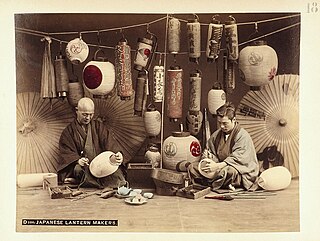
The traditional lighting equipment of Japan includes the andon (行灯), the bonbori (雪洞), the chōchin (提灯), and the tōrō (灯篭).

Stone lanterns are a type of traditional East Asian lantern made of stone, wood, or metal. Originating in China, stone lanterns spread to Japan, Korea and Vietnam, though they are most commonly found in both China – extant in Buddhist temples and traditional Chinese gardens – and Japan. In Japan, tōrō were originally used only in Buddhist temples, where they lined and illuminated paths. Lit lanterns were then considered an offering to Buddha. Their use in Shinto shrines and also private homes started during the Heian period (794–1185).

Nilavilakku is a traditional lamp used commonly in Kerala as well as in Tamil nadu. It is called Deepada Kamba in Karnataka. The traditional lamps which is lit during every auspicious occasions; in temples before the worship starts; at the official and unofficial functions.

Pottery and ceramics have been produced in the Levant since prehistoric times.
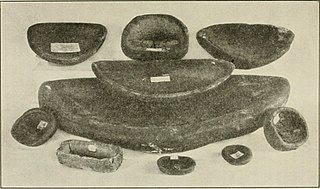
The qulliq, is the traditional oil lamp used by Arctic peoples, including the Inuit, the Chukchi and the Yupik peoples.

Pottery was produced in enormous quantities in ancient Rome, mostly for utilitarian purposes. It is found all over the former Roman Empire and beyond. Monte Testaccio is a huge waste mound in Rome made almost entirely of broken amphorae used for transporting and storing liquids and other products – in this case probably mostly Spanish olive oil, which was landed nearby, and was the main fuel for lighting, as well as its use in the kitchen and washing in the baths.
A Wells light was a large paraffin-fuelled (kerosene) blowlamp used for engineering work, particularly for illumination, in Victorian times. At a time before widespread electrical lighting, they were the most common form of high-powered portable illumination used for construction work, particularly railways, civil engineering, shipyards and ironworks.
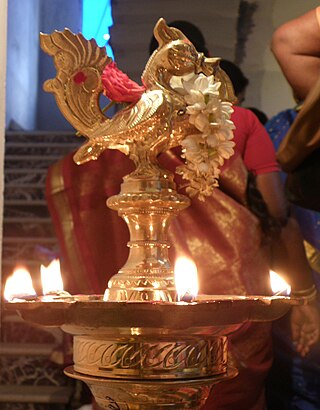
The Nachiarkoil lamp, also called Annam lamp or Nachiarkoil Kuthuvilakku, is an ornamental brass lamp made of series of diyas, a handicraft product which is exclusively made by Pather (Kammalar) community in Natchiarkoil town in Tamil Nadu, India. The lamp, which is hollow cast, is made in different sizes and consists of four parts which are screwed together. The central pillar that crowns at the apex is called the "Prabhai"; it is generally in the form of a hamsa or swan. The lamp may also be made in the form of a female figurine holding a shallow bowl in a standing posture, or in the form of branches of a tree; the bowl of these lamps has five V-shaped spouts which hold cotton wicks, and is filled with oil for lighting. The ornamental lamps are widely used in temples in South India.


